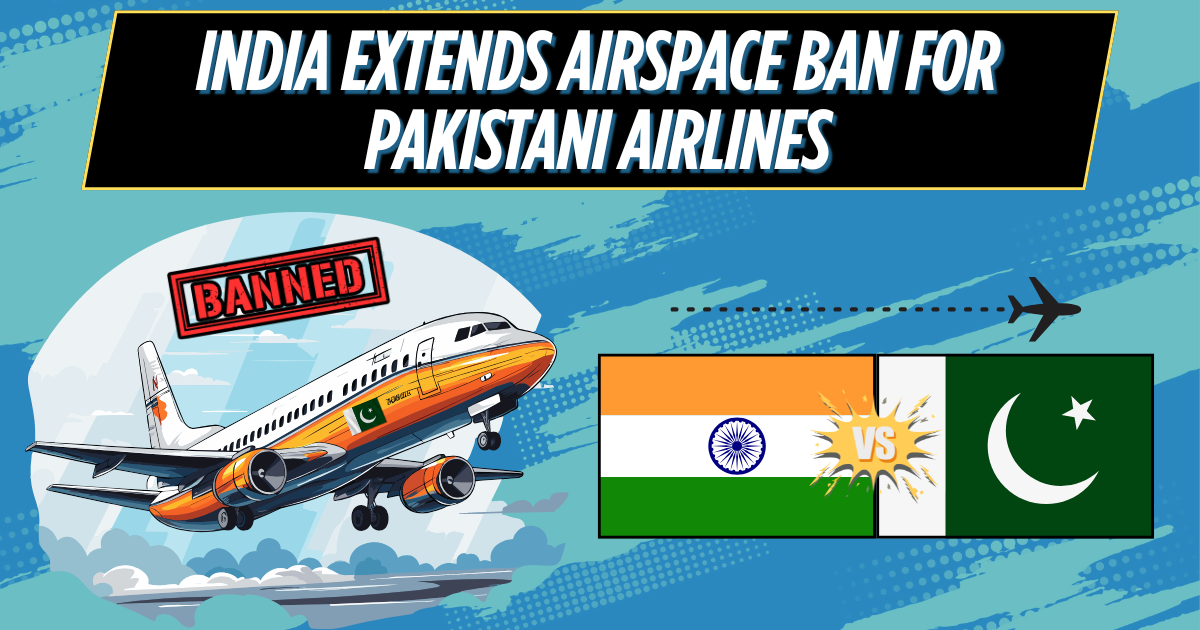India Extends Airspace Ban for Pakistani Airlines Until June 23 Amid Ongoing Diplomatic Tensions. The war between India and Pakistan has surely stopped, but the ongoing diplomatic tension between these two countries is still there. Due to this, India and Pakistan have extended the aircraft ban to each other’s aircraft. This decision has been taken due to the cross-border support of terrorism by Pakistan, and the restriction was imposed on April 30. To know more about the topic “India Extends Airspace Ban for Pakistani Airlines Until June 23 Amid Ongoing Diplomatic Tensions,” read the complete article.
India Extends Airspace Ban for Pakistani Airlines Until June 23 Amid Ongoing Diplomatic Tensions
India and Pakistan extended the airspace ban for airlines on Friday due to the ongoing diplomatic tensions because of the near-war conflict this month. The Civil Aviation ministry of India issued a NOTAM (Notice to Airmen) stating that any Pakistani-registered, operated, owned, or leased aircraft, including military flights, would be barred from entering or using Indian airspace through 23 June. The Pakistan Airports Authority said the restriction applied to “all aircraft registered, operated, owned, or leased by India,” including military planes, until 4:59 a.m. local time on June 24 (2359 GMT on June 23).

“No flights operated by Indian airlines or operators will be able to use Pakistani airspace,” the authority said, adding that the ban also applied to Indian military aircraft. The two neighboring nations closed their airspaces multiple times during the hostilities earlier this month. Pakistan reopened its airspace for all types of flights on May 10 after the ceasefire was announced. The root cause of all these restrictions and bans is the Phalgam attack that killed 26 Indian civilians. Pakistan took this step following India’s suspension of the Indus Waters treaty and other diplomatic ties.
The airline’s ban has been implemented by both countries. The main cause is because of the terrorist attack on Pahalgam in Kashmir. India blames Pakistan for providing shelter to many countries’ terrorists. The tension was declared after an Indian Air Force source reported that Lahore Air Traffic Control had rejected the flight landing permission for an IndiGo Delhi-Srinagar flight due to significant turbulence caused by a hailstorm, citing the existing ban. Following the ceasefire, Pakistan temporarily restored full access to its airspace, but the prohibition on Indian flights remained in place, leading India to follow suit.
Effects of This Ban
The effect of the ban on aircraft by India on Pakistan has some serious consequences also. It is not profitable for both countries. Air India, which relies on overflight routes across Pakistan for its international operations, estimates a USD 600 million loss over the next year due to longer detours and increased fuel expenses. The airline has approached the government asking for financial assistance to reduce the impact. With both countries enforcing mutual airspace bans, suspending trade, and scaling back diplomatic relations, the standoff marks one of the most serious escalations in recent times between India and Pakistan.
IndiGo Controversy
The extensions follow a recent incident pointing out the unwillingness to collaborate in difficult situations. Pakistan allegedly refused support to an Indian airline flight in severe turbulence. On Wednesday, May 21, 2025, an IndiGo Airlines pilot on a Delhi-Shrinagar flight asked Lahore Air Traffic Control (ATC) for permission to briefly enter Pakistani airspace in order to avoid an unexpected hailstorm. Sources quoted by PTI stated that the request was rejected. The IndiGo flight, carrying 277 passengers, was flying over Amritsar when the pilot encountered major turbulence due to adverse weather.
Even after the rejection from Lahore ATC, the pilot continued on the initial path, maneuvering through severe turbulence. The dramatic ordeal on Wednesday saw Flight 6E2142 pelted by a hailstorm as it neared its location. The pilot announced an emergency with Air Traffic Control but successfully landed the aircraft at Srinagar Airport at 6:30 P.M. However, the mid-air turbulence caused visible harm to the aircraft’s nose and left passengers visibly shaken and in a state of panic.
The repeated airspace closures are having a huge impact on flight routes, increasing travel times and operational costs for airlines. With both nations digging in their heels, the prospect of a de-escalation appears dim, further complicating regional connectivity and raising concerns about potential miscalculations in an already volatile environment.



